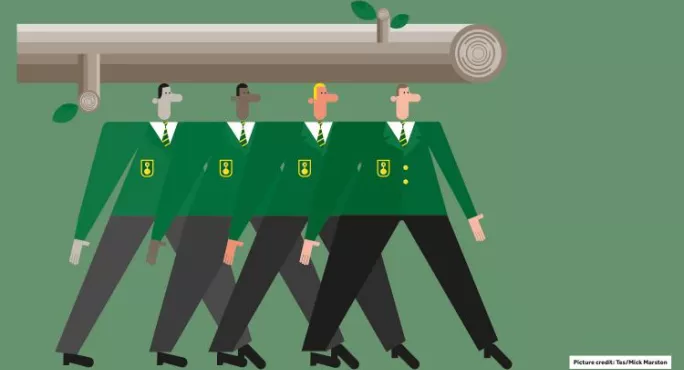- Home
- The day I taught in a military-style academy
The day I taught in a military-style academy

I recently got a job working one day a week in the same school for a half term. The school was one of several run by a new academy chain. I’d heard stories about these places; run on corporate lines, where efficiency and consistency were the watchwords for success. Now I was going to be on the inside. In the interest of full disclosure, I should make it clear I’m not a huge fan of the academy chain model of education; I think education should be student-centred and flexible enough to suit the specific needs of its intake. So it’s just possible a hint of bias may creep into this article.
The tone was set on my first morning as I watched the entire school lining up in the playground. I was struck by something very strange. To begin with I couldn’t put my finger on it. Then it hit me. The 600 teenage children waiting to be registered were silent. Not a rustling of sweet wrappers, not a sniff, not a cough, not a whispered “your mum”. Nothing. In over 20 years of teaching, I have never seen that happen. This was impressive stuff.
Things became a little clearer as to how this miracle was achieved when the headteacher made his appearance. Dressed in a sharp suit and wearing shades (yes, it was 8.45am) he was a man with a commanding presence. He walked up and down the rows of students for a full minute before he began his morning address.
He commended the students on their impeccable uniform. It was indeed impeccable. This also seemed a little odd. Students will usually find ways to subvert uniform rules: a shortened tie, a rolled-up skirt, a non-regulation hairband. Not here. It was as if the Midwich Cuckoos had resurfaced in north London.
Then came the core of the head’s address. It had come to his notice, he said, that some students had not been bringing the correct equipment to their lessons. To emphasise his point he produced a student diary and read through the list of classroom essentials, two black pens, one green pen, ruler, and so on.
Back when I taught PSHE, a standard lesson starter would be to have the class draw up a list of ground rules for the session. The thinking being that if the stakeholders (sorry, kids) were involved in setting the rules they’d be more inclined to follow them. There was to be none of that free-thinking lefty nonsense here. The ethos was straightforward: here are the rules, follow the rules, do not question the rules.
On one occasion I saw three students pulled out of the morning line-up for talking. They were asked to take out their diaries to record the 30-minute detention. “I’ve already got mine out, sir,” one boy replied meekly. His detention was instantly doubled for talking back.
It would be fair to say there was a touch of the military academy about the place. Personally, I’ve always believed that to get the best out of kids, you have to let them be kids. And while I’ll accept that the iron rod will work for some, walking silently in straight lines doesn’t feel like natural behaviour for teenagers. Squash it down here, it’s going to force its way out somewhere else.
I saw one glorious example of just that. The rule on silence when moving from playground to classroom had one exception: students were permitted to say thank you to the prefects holding the doors. Perhaps inevitably, some chose to take advantage of this tiny window for self-expression, roaring or squeaking their thanks with obvious delight. I find it oddly reassuring that whenever you create a rule, kids will find a creative and totally unexpected way to flout it.
Another aspect of a certain breed of academy chain is the belief that success can be achieved by following the model of our successful public schools. For example, here, the school’s motto in Latin was plastered all over every exercise book. On a hunch, I asked a few kids how it would be translated. I won’t say none of them knew, but out of the dozen or so I asked, only a couple had a clue. I’m not blaming the kids for this, I just question the relevance of Latin to a predominately working class inner-city cohort.
Trying to emulate the success of the private sector by only copying certain elements, uniform, discipline, Latin mottos and so on, just doesn’t work. Because of course, those are not the key factors that contribute to the success of private schools. They have more money, a selective intake and don’t have to put up with a never-ending round of government interference. You may as well try serving hot crumpets every day at 3pm in the hope this suddenly causes every student to meet their targets.
Just because the high-achieving schools happen to wear knee breeches and play fives, it doesn’t follow that if an academy chain does the same, the results will miraculously improve. I believe that’s what’s known as a post hoc fallacy. But then I guess they wouldn’t know that.
The writer has recently taken up supply teaching after 20 years in a full-time teaching job.
Keep reading for just £1 per month
You've reached your limit of free articles this month. Subscribe for £1 per month for three months and get:
- Unlimited access to all Tes magazine content
- Exclusive subscriber-only stories
- Award-winning email newsletters



